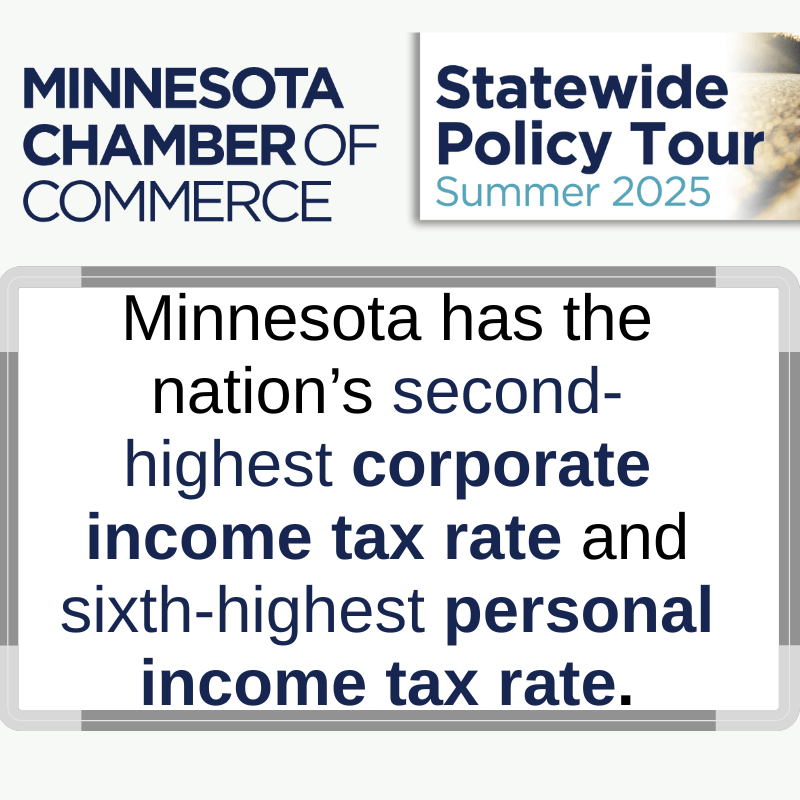Minnesota Chamber of Commerce: 2025 Legislative Session Highlights for Businesses

Minnesota Chamber Summarizes Legislative Session for Austin Businesses
The Minnesota Chamber of Commerce recently presented key legislative updates from the 2025 session at an event hosted by First Farmers & Merchants Bank at Austin Utilities. The session, marked by a historic tie in the Minnesota House, forced compromise and resulted in a more restrained approach compared to the previous biennium. Below, we summarize the critical issues impacting member businesses, focusing on economic competitiveness, taxes, workplace mandates, healthcare, environmental regulations, and transportation.

Economic Challenges Facing Minnesota Businesses
Minnesota’s economic performance is lagging, with GDP growth, job growth, and other key metrics falling below national averages and trailing neighboring Upper Midwest states. The Chamber emphasized that rising costs of doing business—driven by recent legislative decisions—hinder the state’s potential for growth. The 2023-2024 biennium saw an $18 billion surplus turn into a $6 billion deficit, with $10 billion in new taxes and a 40% state budget increase. Over 35 new workplace mandates, along with regulations on chemicals, permitting, health insurance, and electricity, further strained businesses.
The 2025 session, shaped by a 67-67 House split and 21 new legislators, prioritized passing a balanced state budget and maintaining the reinsurance program for stabilizing individual health insurance markets. The Chamber’s advocacy centered on the theme “costs matter,” aiming to address policies that raise business expenses and undermine competitiveness.

Budget and Fiscal Responsibility
The state faced a constrained budget with a $2.2 billion deficit projected for the current biennium and a $3.5 billion shortfall in the next. Despite a $3.7 billion surplus carryover, the session focused on fiscal restraint. Lawmakers cut $283 million in spending—primarily in health and human services, transportation, and taxes—reducing the projected deficit for 2027-2028 by 45% to $2.1 billion. However, these cuts targeted services rather than state agencies, which received increased funding, raising concerns about uneven reductions. The Chamber views this as a spending problem, not a revenue issue, and will continue advocating for prudent fiscal policies.

Tax Policy: Protecting Businesses from New Burdens
Minnesota’s high tax environment, with the nation’s second-highest corporate income tax rate and sixth-highest personal income tax rate, remains a challenge for businesses. The Chamber successfully opposed several proposed tax increases, including:
- A new fifth-tier personal income tax for high earners, which would have raised rates to 12.45%.
- A corporate tax rate increase to 12.45%.
- An expansion of sales tax to professional services like banking, accounting, and legal fees.
- A novel social media tax of 50 cents per user per month, projected to generate $170-$180 million biennially.
- Reductions in net operating loss deductions.
Positive outcomes included a 25% refundable research and development tax credit to support innovation-driven businesses and an extension of data center sales tax incentives, despite a partial repeal of electricity exemptions. The Chamber aims to simplify tax compliance and pursue long-term goals of reducing personal and corporate income tax rates to improve competitiveness.

Workplace Mandates: Seeking Balance and Workability
The 2023-2024 sessions introduced significant workplace mandates, such as paid sick and safe time and paid family and medical leave (effective January 1, 2026), increasing compliance costs and legal exposure for employers. Small business exemptions were largely removed, impacting even smaller firms. The Chamber’s 2025 priorities included preventing new mandates and refining existing ones for workability.
Key refinements achieved:
- Paid Sick and Safe Time: Reduced the documentation waiting period from three to two days, allowed reasonable employer-defined documentation, and permitted prorated front-loading of hours for new hires.
- Paid Family and Medical Leave: Capped the payroll tax at 1.1% (down from 1.2%) to contain costs if the program becomes oversubscribed. Employers with 30 or fewer employees and wages 150% above the state average qualify for a reduced payroll tax.
The Chamber blocked significant new mandates, including proposals for unemployment insurance for striking workers, a $20 minimum wage by 2029, mandatory holiday overtime, and reclassification of independent contractors as W-2 employees. These issues are likely to resurface, and the Chamber encourages businesses to engage legislators to highlight their impact.
Healthcare: Controlling Costs and Maintaining Stability
Minnesota’s individual health insurance market relies on the reinsurance program, which has reduced premiums by up to 25% annually. The Chamber secured funding for this program for the next two years, ensuring market stability. However, the state’s second-longest list of health insurance mandates—expanded by 15 in the last biennium—continues to drive up costs. Nine new mandate proposals in 2025, which could have added $60/month to family premiums, were successfully blocked, as were most proposed healthcare taxes, except a $2 million insurance cost increase.
The Chamber also supported hospitals in securing increased federal Medicaid funding to reduce cost-shifting to private insurance payers. Efforts to prevent the expansion of public programs like MinnesotaCare to all income levels succeeded, avoiding further cost and access challenges. The Chamber advocates for state funding of public health imperatives to ease the burden on private businesses.
Environmental Regulations: Streamlining Permitting
Environmental permitting delays and costs have been a pain point for businesses. Following a 2024 Chamber Foundation report identifying deficiencies, the 2025 session passed a compromise bill to streamline the process. Key reforms include:
- A five-day grace period to address incomplete permit applications.
- Clarified reporting requirements for permitting efficiency.
- Elimination of redundant 70% reviews for large projects.
- Simultaneous permitting for local and state environmental reviews.
- Incentives for the Minnesota Pollution Control Agency (MPCA) to use certified consultants for expedited permits.
The Chamber opposed a proposed tax on products with circuit boards or batteries, an extended producer responsibility program, and new air dispersion modeling requirements for utilities, which would have increased consumer costs. A potential ban on PFAS in consumer products was scaled back, exempting items without skin or mouth contact, and lead standards for keys and other products were aligned with California’s, avoiding a de facto ban.
Transportation: Infrastructure Funding and Policy Shifts
The budget deficit threatened general fund support for transportation infrastructure, with some funds redirected back to the general fund—a concerning precedent. The Chamber advocated for sustainable funding as electric vehicles (EVs) reduce gas tax revenue. New policies include:
- Increased EV registration fees (from $75 to $150 or a calculated amount based on vehicle value).
- A 5-cent per kilowatt-hour tax on for-profit EV charging stations, with exemptions for public chargers at state or local facilities.
Efforts to delay a 2023-2024 requirement for greenhouse gas and vehicle miles traveled mitigation in road expansion projects were unsuccessful, though mitigation definitions were broadened. The Chamber also maintained existing tax credits for sustainable aviation fuel to support Minnesota’s ag-based economy but could not secure additional incentives.
Looking Ahead: Engaging for Change
The 2025 session’s divided government slowed the pace of new mandates and spending, offering businesses some breathing room. However, challenges like the paid family and medical leave rollout, persistent budget deficits, and high tax rates remain. The Austin Area Chamber encourages our members to share pain points with legislators, particularly regarding small business impacts, to shape the 2026 session. We also partner with the Minnesota Chamber to advocate for businesses across the state on issues such as employer mandates, tax rates, and healthcare costs.
For compliance resources and updates, visit the Minnesota Chamber of Commerce website. Together, we can work toward a more competitive business environment in Minnesota.

